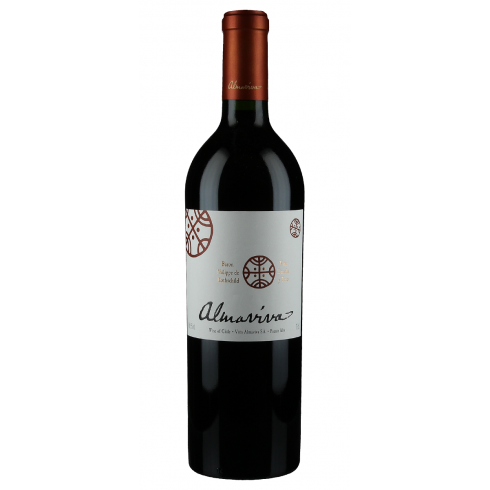ALMAVIVA 2019
ALMAVIVA 2019
CHILE, Puente Alto
Remark : Min. Order Qty (MOQ) 1 case of 6 bts & multiple of full case Qty
SPECIAL OFFER :-
Min 12 Btls : $1,280/Btl
98/100 points James Suckling - Vintage 2018 (April 2020)
This is such a beautifully nuanced red with tobacco, dried herbs, wet earth and currants. Some leather and rose petals, too. Full-bodied and chewy, yet refined with great polish. It’s rich and intense at the same time. Very focused center palate. Broad layers of tannin and fruit. A blend of 72% Cabernet Sauvignon, 19% Carmenere, 6% Cabernet Franc and 3% Petit Verdot.
96/100 points Robert Parker's Wine Advocate (August 2020) Luis Gutiérrez
The varietal breakdown is 72% Cabernet Sauvignon, 19% Carmenère (from Peumo), 6% Cabernet Franc and 3% Petit Verdot. The grapes ripened thoroughly, as the 14.9% alcohol of the final blend shows, a little higher than previous years and with similar readings of acidity. The wine feels quite complete and nicely crafted... It's a solid, well-built and seamless Almaviva, with clout and balance. 2018 was a more homogeneous vintage, globally considered one of the best in recent times in Chile. They identify a great vintage when they see more homogeneous quality in their different wines, and winemaker Michel Friou explained that this year some wines from three- or four-year-old vines were really good. It feels like a very complete wine, from a year when the seasons were marked and when the plant followed the development with almost textbook conditions—the grapes ripened thoroughly, developing more flavors and nuances while keeping the freshness. This is still a baby, extremely young and creamy, but it is still approachable; there are no edges, but what's remarkable is the balance and stuffing and all the necessary ingredients for a great development in bottle. This is quite different from 2016; it's a vintage with power and clout, a wine that has fruit and intensity and is balanced, without the concentration and tannins of the 2017. It’s a more complete year that combines the finesse of 2016 with more thorough ripeness... (LG)
James Suckling 100/100 - 25th April 2019 News
Almaviva 2017 receives maximum score
The famous critic James Suckling on his last visit to our country in April 2019, and after having tasted more than 1,200 Chilean wines, recognized with 100 points Almaviva 2017 describing it as a wine with “aromas of blackberry leaves and iodine are wild and exotic here with mussel shells and earth underneath. Full-bodied, tight and chewy with powerful tannins that show muscle. It’s structured and powerful. Dense and very, very deep”
It is important to highlight that this is the second time that Almaviva receives this perfect score after vintage 2015 that was distinguished the same way.
Wine Advocate (Robert Parker) 94+/100 - Luis Gutiérrez - 31st August 2019
2017 was an unusual year, warm and extremely dry (178 liters of rain, but there was some rain after the 2016 harvest, so the soil had some water), and the harvest and the whole cycle was two to three weeks earlier than normal. That is the context for the 2017 Almaviva, whose vines saw extremely low yields (ten hectoliters per hectare in the older parts, 36 hectoliters per hectare in the young vines) and produced concentrated juice. The bottled blend is 65% Cabernet Sauvignon, 23% Carmenère, 5% Cabernet Franc, 5% Petit Verdot and 2% Merlot, quite similar to the 2016, and the alcohol level reached 14.6% with a pH of 3.65 and 4.9 grams of acidity (measured in tartaric acid). It matured in French oak barriques (825 of them new) for 19 months. It's a riper, rounder and softer vintage, with moderate acidity and a tender mouthfeel, really marked by very high temperatures all year round. They used a little more Petit Verdot in the blend, but there is no overripeness. The wine shows some herbal aromas (I really notice the touch of the Carmenere this year). They harvested extremely early (three weeks earlier than normal!) and were able to keep the tension in the wine, and it has a polished mouthfeel and very round tannins. It's a nicely crafted red blend, and they were able to overcome the difficulties of the year; I see the style of something between 2016 and 2015, quite compact. It might require some more bottle age to open up, and it should develop nicely in bottle. 180,000 bottles produced. It was bottled in January 2019.
I tasted the new release of Almaviva, 2017, and as always, I also had the last couple of vintages and some older wines to check the evolution of the wines in bottle as well as to see how the winemaking has changed over the years. The wines have evolved positively, and I was surprised by the 1998—at the time considered one of the worst years ever, the wine shows more of a Bordeaux style. 2006 is definitely more Chilean, and 2008 had a very cold winter but overall was very dry. 2015 and 2016 showed pretty much like I tasted them on release, with 2016 still one of my favorite years ever, classical and herbal, and 2015 a little riper and evolving faster than 2016. As for 2017, it was another warm and very dry year, with terrible fires, though they did not have any impact in the Almaviva vineyards.



